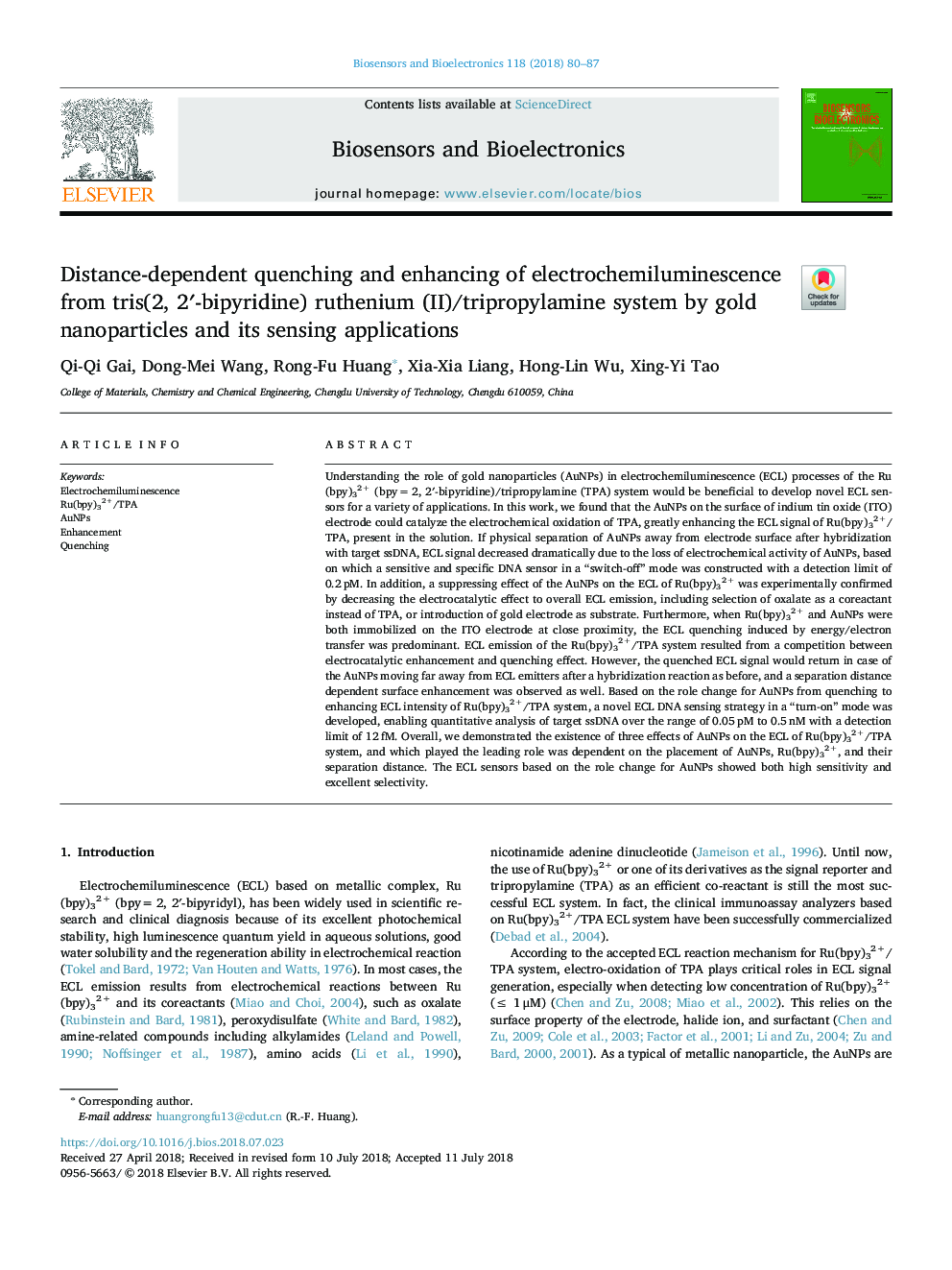| کد مقاله | کد نشریه | سال انتشار | مقاله انگلیسی | نسخه تمام متن |
|---|---|---|---|---|
| 7228920 | 1470914 | 2018 | 8 صفحه PDF | دانلود رایگان |
عنوان انگلیسی مقاله ISI
Distance-dependent quenching and enhancing of electrochemiluminescence from tris(2, 2â²-bipyridine) ruthenium (II)/tripropylamine system by gold nanoparticles and its sensing applications
دانلود مقاله + سفارش ترجمه
دانلود مقاله ISI انگلیسی
رایگان برای ایرانیان
کلمات کلیدی
موضوعات مرتبط
مهندسی و علوم پایه
شیمی
شیمی آنالیزی یا شیمی تجزیه
پیش نمایش صفحه اول مقاله

چکیده انگلیسی
Understanding the role of gold nanoparticles (AuNPs) in electrochemiluminescence (ECL) processes of the Ru(bpy)32+ (bpy=â¯2, 2â²-bipyridine)/tripropylamine (TPA) system would be beneficial to develop novel ECL sensors for a variety of applications. In this work, we found that the AuNPs on the surface of indium tin oxide (ITO) electrode could catalyze the electrochemical oxidation of TPA, greatly enhancing the ECL signal of Ru(bpy)32+/TPA, present in the solution. If physical separation of AuNPs away from electrode surface after hybridization with target ssDNA, ECL signal decreased dramatically due to the loss of electrochemical activity of AuNPs, based on which a sensitive and specific DNA sensor in a “switch-off” mode was constructed with a detection limit of 0.2â¯pM. In addition, a suppressing effect of the AuNPs on the ECL of Ru(bpy)32+ was experimentally confirmed by decreasing the electrocatalytic effect to overall ECL emission, including selection of oxalate as a coreactant instead of TPA, or introduction of gold electrode as substrate. Furthermore, when Ru(bpy)32+ and AuNPs were both immobilized on the ITO electrode at close proximity, the ECL quenching induced by energy/electron transfer was predominant. ECL emission of the Ru(bpy)32+/TPA system resulted from a competition between electrocatalytic enhancement and quenching effect. However, the quenched ECL signal would return in case of the AuNPs moving far away from ECL emitters after a hybridization reaction as before, and a separation distance dependent surface enhancement was observed as well. Based on the role change for AuNPs from quenching to enhancing ECL intensity of Ru(bpy)32+/TPA system, a novel ECL DNA sensing strategy in a “turn-on” mode was developed, enabling quantitative analysis of target ssDNA over the range of 0.05â¯pM to 0.5â¯nM with a detection limit of 12â¯fM. Overall, we demonstrated the existence of three effects of AuNPs on the ECL of Ru(bpy)32+/TPA system, and which played the leading role was dependent on the placement of AuNPs, Ru(bpy)32+, and their separation distance. The ECL sensors based on the role change for AuNPs showed both high sensitivity and excellent selectivity.
ناشر
Database: Elsevier - ScienceDirect (ساینس دایرکت)
Journal: Biosensors and Bioelectronics - Volume 118, 30 October 2018, Pages 80-87
Journal: Biosensors and Bioelectronics - Volume 118, 30 October 2018, Pages 80-87
نویسندگان
Qi-Qi Gai, Dong-Mei Wang, Rong-Fu Huang, Xia-Xia Liang, Hong-Lin Wu, Xing-Yi Tao,